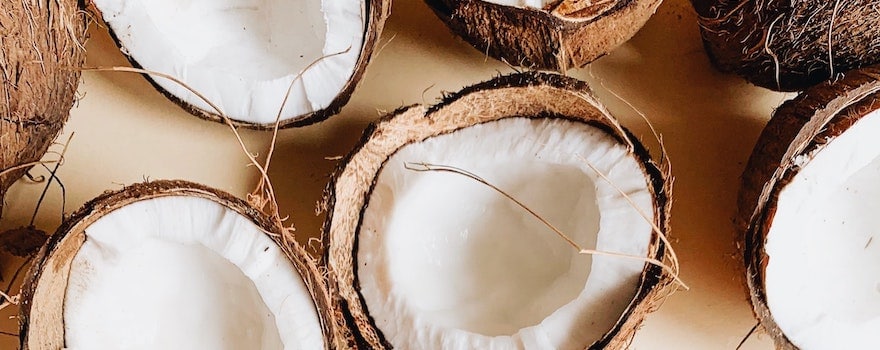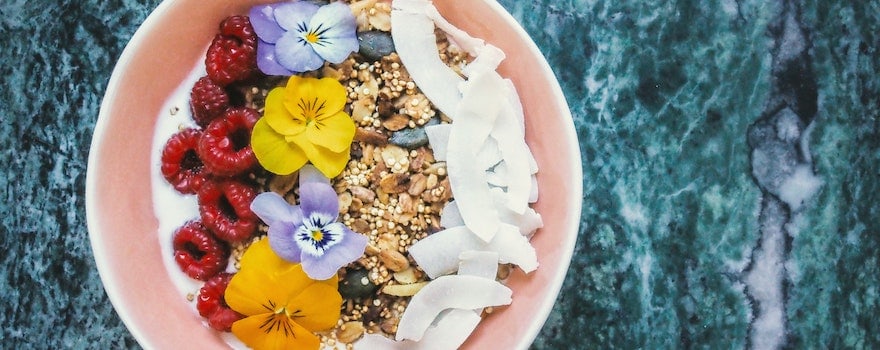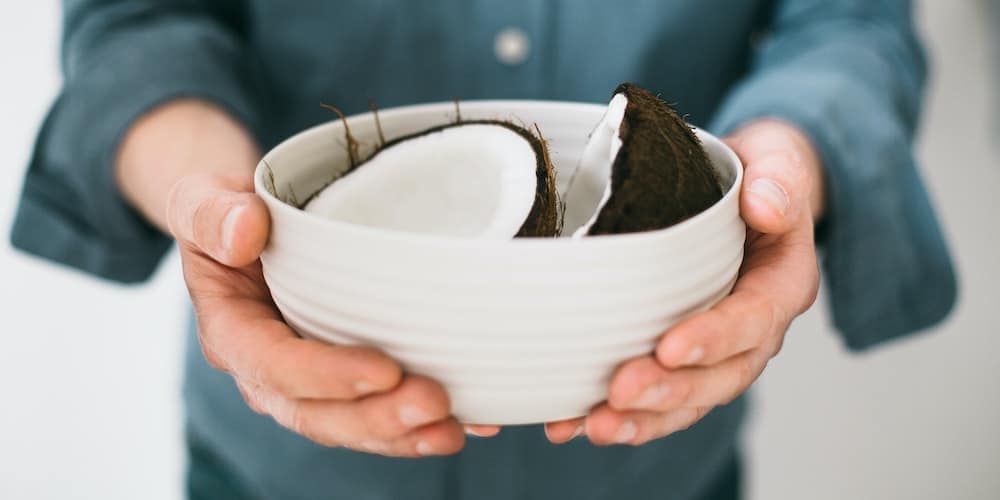What is coconut?
The coconut is the fruit of the coconut palm (Cocos nucifera). It is a species of palm belonging to the Arecaceae family, like the date palm. Originally from Malaysia, it now grows in many tropical regions: Southeast Asia, South America, Pacific islands…
It can reach 30 m in height and produces large fruits that can weigh up to 1.5 kg.
Coconut has long been consumed for its nutritional qualities and medicinal properties. In India, it is called “Kalpavriksha” which means “tree that gives everything” in Sanskrit. The fruits are versatile and allow for numerous by-products: water, cream, or coconut oil.
Very rich in water, it is also a source of vitamins and minerals. Studies also reveal an antioxidant and cardio-protective action. Finally, it is interesting for improving and supporting cognitive functions such as memory.
Nutritional Composition
- Amino acids
- Vitamins: B1, B2, B3, B5, B6, B9, C, E, K
- Minerals and trace elements: magnesium, zinc, manganese, phosphorus, potassium, calcium, copper, iron, sodium, iodine
- Water
- Lipids
- Proteins
- Fibers
- Carbohydrates
- Fatty acids: lauric acid, myristic acid, palmitic acid
- Antioxidant compounds: polyphenols (gallic acid, ferulic acid, quercetin)

The benefits of coconut
💦 Hydrating
Coconut is composed of about 45% water. This is what makes it particularly hydrating and thirst-quenching. Thus, it contributes to the body’s daily water needs. It compensates for water losses throughout the day.
Coconut water is ideal for athletes. It allows for good rehydration after exercise. Moreover, it provides all the essential electrolytes to the muscles: magnesium, potassium, sodium, calcium, and phosphorus.
This drink is remineralizing and helps restore the hydro-mineral losses caused by sweating.
This study from the Sains Malaysia University in Kelantan (Malaysia), conducted on athletes, shows the hydrating action of coconut water.
🍽 Source of vitamins and minerals
The fruit contains a variety of vitamins, minerals, and trace elements. The B-group vitamins are very well represented. Notably, it contains vitamin B6 which supports the immune system and participates in the synthesis of several hormones.
Vitamin C is also present in significant quantities: about 3 mg per 100 g.
Regarding minerals, it is an excellent source of potassium with about 350 mg per 100 g. This element is essential for muscle functioning. It also provides iron, manganese, copper, and zinc. Thus, it actively participates in the recommended daily intake and limits deficiencies.
This review from Nanyang Technological University (Singapore) studies in detail the composition of coconut water.
🥝 Antioxidant
Polyphenols are the main antioxidants in coconut. They are composed of gallic acid, ferulic acid, and quercetin. They fight against free radicals and protect the body’s cells.
Selenium, manganese, and zinc are also antioxidants. Their action is complemented by that of vitamins C and E. They act against cellular aging by limiting the production of free radicals.
This review from the Amala Cancer Research Center (India) shows how coconut oil protects cells from pro-oxidant damage.
❤️ Protects the heart
Its consumption is interesting for protecting the heart. Indeed, it reduces high levels of cholesterol and triglycerides and lowers blood pressure. All factors responsible for cardiovascular diseases.
Moreover, it facilitates the contraction of heart muscles. Potassium ensures the maintenance of the heartbeat.
This study from the University of Otago (New Zealand), conducted on humans, shows how coconut oil supports cardiovascular health.
🧑🏫 Improves memory
Coconut also has beneficial effects on the nervous system. It supports cognitive functions and notably improves memory.
On one hand, its fatty acids ensure the protection of neurons. On the other hand, polyphenols prevent the aggregation of amyloid-β peptide, involved in Alzheimer’s disease. Finally, by acting on neurotransmitters, magnesium improves cerebral and cognitive functions.
This review from Edith Cowan University (Australia) shows the potential of coconut in the prevention and treatment of Alzheimer’s disease.

How to consume coconut?
Fresh coconut
The coconut tree produces almost all year round. Fresh fruits are therefore easy to find in market stalls or in stores. The best period is from November to February.
Choose a heavy fruit, without cracks and without mold traces. You should also hear the water sloshing when shaking. Once opened, you can drink the coconut water or consume the flesh, either plain or grated.
Discover how to open a coconut at the end of this article!
Coconut water
Also called “coconut juice”, it is naturally present in the fruit. It contains 94% water and very few calories. It is refreshing and a good slimming ally.
It can be enjoyed pure or added to cakes, biscuits, cocktails, mocktails, smoothies… You can also use it in cosmetics for skin and hair care. It is moisturizing, antioxidant, anti-inflammatory, and anti-aging.
Coconut milk
It is obtained by grinding coconut flesh and adding hot water. It has a creamy consistency. It can be used in cooking, particularly in baking. You can also add it to purees, soups, chicken, or fish curries…
Finally, it is a delicious lactose-free drink and casein-free.
Coconut cream
It is made from the same process with less water than coconut milk. This is why it has a thicker and more creamy texture.
It is a plant-based alternative to heavy cream. It can be used in desserts as well as in fish, vegetable, or poultry dishes.
Coconut oil
It is extracted from the fresh pulp of the fruit, which is pressed and then finely ground. In cooking, it is used for cooking (up to 177°C), to replace fats, or to make your sauces and dressings.
Choose virgin coconut oil, cold-pressed, unrefined, and organic.
Externally, coconut oil is also beneficial for hair.
Coconut flour
Once extracted, the coconut flesh is dried and defatted. It is then ground to obtain flour with a mild and slightly sweet taste. It is used in recipes for cakes, tarts, pastries… Add it to a proportion of 15 to 25% of the preparation and complete with another flour.
It is a gluten-free flour with a low glycemic index (GI 35).

Sustainable consumption: prioritize organic and fair trade coconut
✓ L’Indonésie, les Philippines et l’Inde sont les principaux producteurs mondiaux. Malheureusement, la demande grandissante engendre des dérives : utilisation massive de pesticides, maltraitance animale (« singes esclaves »)…
✓ Privilégiez des fruits cultivés en agriculture biologique et issus de filières équitables. Ainsi, vous soutiendrez le travail des producteurs locaux.
Dosage
There is no particular recommended dosage.
Simply avoid consuming it in excess.
Contraindications and side effects
The consumption of coconut has no contraindications. However, it can trigger allergies in some people.
Consumed in moderation, it does not cause side effects. If you experience any undesirable symptoms, stop consuming and consult a physician.
Sources and scientific studies
Manisha DebMandal, Shyamapada Mandal 2011. Coconut (Cocos nucifera L.: Arecaceae): in health promotion and disease prevention.
I Ismail, R Singh, R G Sirisinghe, 2007. Rehydration with sodium-enriched coconut water after exercise-induced dehydration.
Jean W H Yong, Liya Ge, Yan Fei Ng, Swee Ngin Tan 2009. The chemical composition and biological properties of coconut (Cocos nucifera L.) water.
Soorya Parathodi Illam, Arunaksharan Narayanankutty, Achuthan C Raghavamenon, 2017. Polyphenols of virgin coconut oil prevent pro-oxidant mediated cell death.
Laurence Eyres, Michael F Eyres, Alexandra Chisholm, Rachel C Brown, 2016. Coconut oil consumption and cardiovascular risk factors in humans.
W M A D B Fernando, Ian J Martins, K G Goozee, Charles S Brennan, V Jayasena, R N Martins, 2015. The role of dietary coconut for the prevention and treatment of Alzheimer’s disease: potential mechanisms of action.



